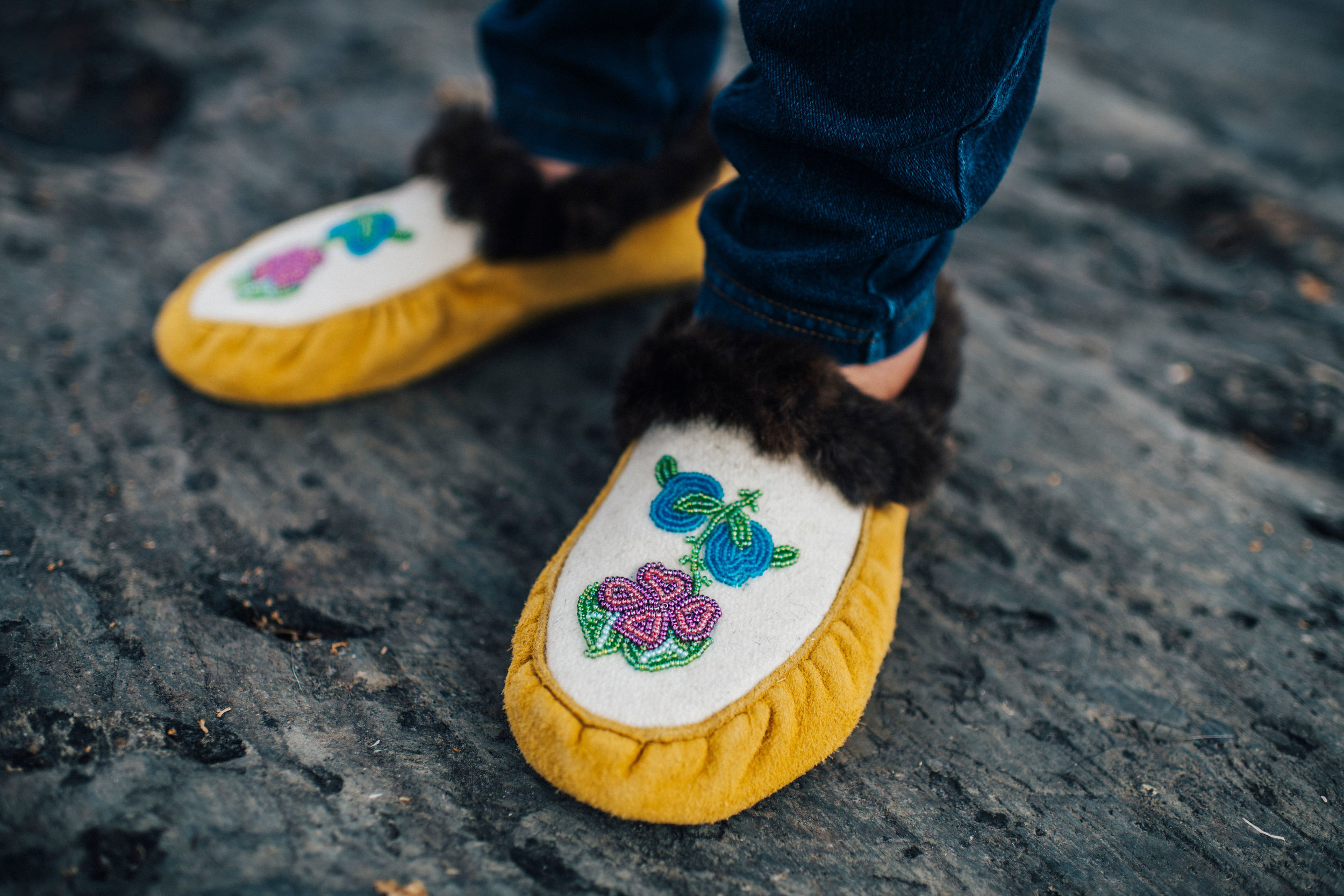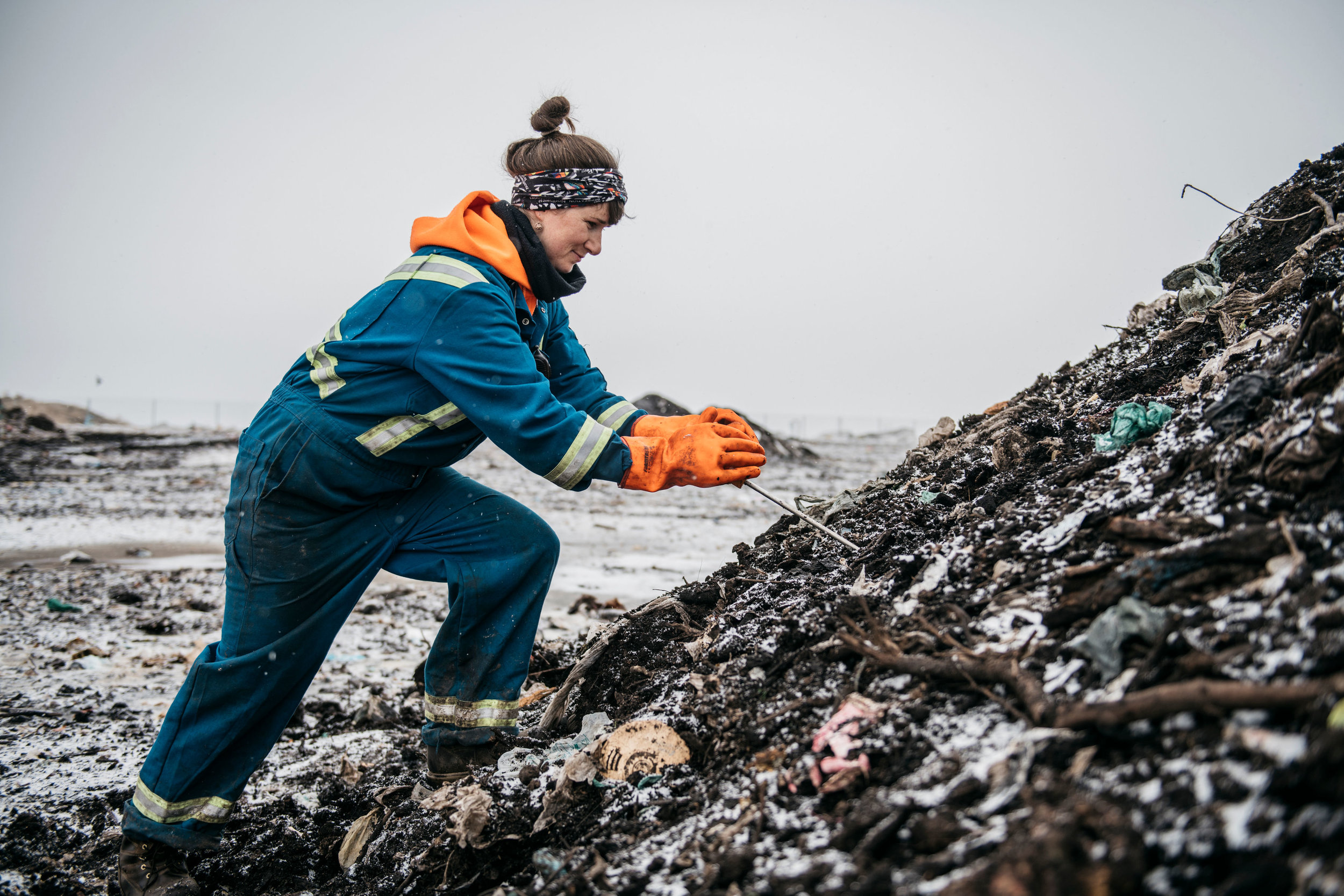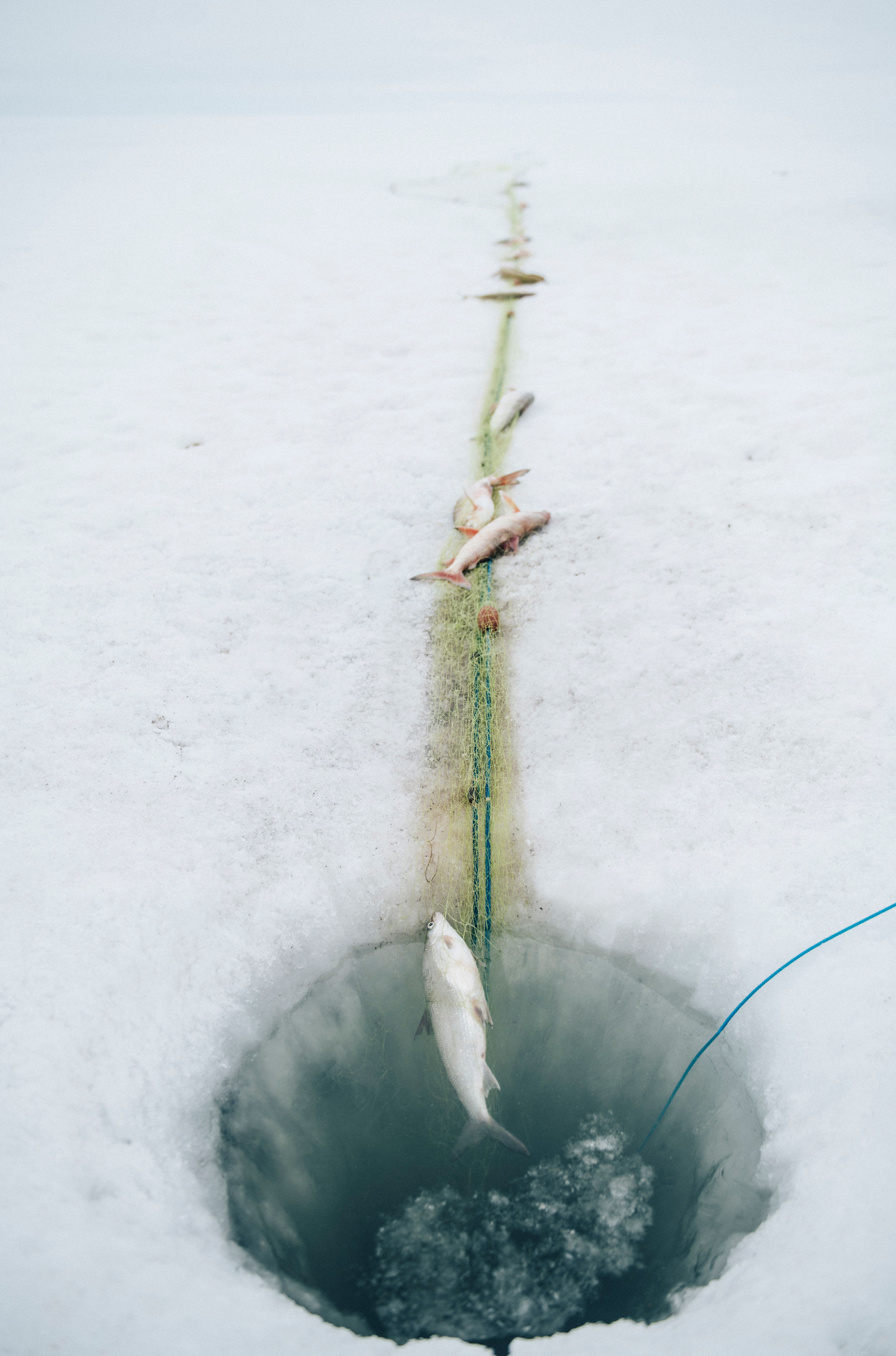


















Jim, a member of Yellowknife’s homeless community, sinks his feet into a basin of warm water. Wednesday night foot washing was started close to 15 years ago by two Arctic College nursing students. Volunteers at the Salvation Army’s foot-washing clinic will file down any calluses, provide minor first aid to sores, apply lotion and give him a foot massage. Self-care can be extremely difficult for the homeless, as the harsh winter conditions and lack of shelter takes its toll on the less fortunate.

Fish being smoked at the Wiliideh River site in preparation for an Aboriginal Day feast. The Dene of the Deh Cho have always lived according to the Dene Laws, they are an important part of the Dene History and Traditions. “Share all the big games you kill; only take what you need and share with others who do not have any.” Economically, traditional foods are more affordable compared to the cost of store-bought foods, especially in Northern and remote communities. Traditional foods are also rich in nutrients. The cultural aspect of traditional foods is also important, as the Dene feel a deep connection to one’s cultural and spiritual identity through consuming traditional foods and events such as feasts or ceremonies.

Be'sha Blondin standing in front of a tipi at the Arctic Indigenous Wellness Camp. Be'sha is one of the elders leading this newly launched project. A First Nation’s Elder from the Sahtu Region of the Northwest Territories with forty years of experience in Indigenous traditional healing. "When anything is built on the land, you get nothing but peace."
This camp is a healing place for Indigenous people, providing a safe space to get counselling, share their stories, or even just chop wood and help out. No pressure is put on individuals to open up unless they are ready and are willing.
“A sense of urgency among the elders of the north to pass down their long-standing healing traditions, which are on the brink of extinction, has prompted the development of a formal strategy and structure to ensure the next generation of indigenous people are as healthy and happy as their ancestors.” - Arctic Indigenous Wellness Camp’s vision statement

Mandee McDonald scrapes a moose hide at the Dene Nahjo's Annual Urban Hide Tanning Camp located at Somba K'e Park. This camp is located in downtown Yellowknife and takes place for two weeks in the summer where residents can witness and learn traditional skills from elders and crafts people. Above all else it offers an opportunity for cultural revitalization and provides an opportunity for hide tanners from several regions to connect and share knowledge.

Marina St Croix, in her home where she was a victim of a stabbing on New Year’s Eve at the hands of her ex-husband while she was pregnant. Luckily her daughters, who were present for the crime, all survived. By the time she arrived at Stanton Territorial Hospital, the young mother says the NWT Health and Social Services Authority were already trying to take her kids away.
"Society must end the cultural norm of blaming the victim and offer help and realize that leaving an abusive relationship is very dangerous and can be lethal."

Shawn Buckley pours a coffee from the water of Great Slave Lake. You can actually see the Yellowknife Water Treatment Plant from the shores where Buckley lives off grid while he works harvesting fish in Yellowknife. Due to archaic regulations, tour companies are required to give bottled water to their guests, instead of using reusable containers to pull clean drinkable water directly from the lake.
Shawn’s now noticing more and more trash along the shores of the lake due to higher traffic. This is particularly troublesome as the number of visitors continues to grow.
“Tourism is so busy that it seems everyone is playing catch up with cleaning up. It’s all accumulating along the shore. Coffee cups and plastic bottles”

Many houseboats are located in the bay of Great Slave Lake. These colourful and energy efficient homes are a perfect example of sustainable living, as most house-boaters live entirely off grid. Heating their homes with wood, using solar power and separator toilets, and drawing water from the lake for dishes and drinking.

Bill Stirling, co-owner of Overlander Sports, snowshoes across Prosperous Lake. A favourite of both tourists and locals alike, Overlander Sports is a local outdoor goods store that has been part of the Yellowknife community since 1983. While the NWT is still heavily reliant on government and mining, small- and medium-sized local businesses are very important to the economy.
“Our store was started because we recognized that there was a need for well-made and well-designed sports equipment. We believe that good gear coupled with knowledgeable staff recommending, fitting, and adjusting it to the end user, (including regular maintenance), simply gives our customers a better sporting experience; and, not only encourages them to continue participating in their chosen activities, but to share their enthusiasm with family and friends. This enthusiasm nurtures more participation by those living in our community and fosters both the development and expression of our physical nature in many alternative and varying ways. Such sports, for example, as sport climbing or kite-skiing were virtually unknown in the Yellowknife of twenty years ago. “

Aurora dance over Prosperous Lake, located east of Yellowknife on the Ingraham Trail. This is a popular recreation highway leading to many protected water-based parks. Numerous cabins and homes are located along the shores of Prosperous Lake, but over the last 15 years roughly 20 new lots and cabin leases have been given out by the Federal and Territorial governments. With Yellowknife mainly being a hub for mining in the past, most of our territorial park’s infrastructure were not built with large numbers in mind. But with tourism being one of the fastest growing sectors in the NWT, these protected parks are seeing a huge increase in numbers. Traffic, congestion and litter are now growing concerns with all of these new visitors flocking to our city for Aurora Borealis viewing and various other tourism-related activities.

Before 2017 it was deemed inappropriate to wear mukluks or moccasins to work at the City of Yellowknife. Removing this racist dress policy in 2017 was symbolic of a larger shift taking place. Maggie Mercredi, now the Indigenous Relations Adviser at the City of Yellowknife, wears the moccasins that her grandmother Nelly made before she passed in 2012. Even though her grandmother was struggling with arthritis and poor eyesight, she still pushed through making such beautiful moccasins. Her grandmother was known for the intricate detail in her bead work and stitching; much harder for her to accomplish in her last couple of years. Maggie’s moccasins help her feel closer to her grandmother after her passing.
“When it comes to things such as discrimination, racism, lateral violence and bullying in our communities or work, it’s our culture that keeps us grounded and the strong Dene people that we are. It helps us through our hardships and keeps us moving forward.”

The glassy waters of Great Slave Lake and Precambrian rocks photographed from a helicopter near the City. Yellowknife’s economy relies on natural resources. Cultural resources and practices in the region are also synonymous with the land and water. Protecting the environment is critical to the economic and cultural longevity of the area.
Strides have been made to incorporate more renewable energy and alternative technologies that assist in lowering the City’s carbon footprint, and to adopt sustainable uses of resources. However, the NWT is still playing catch up to the rest of Canada in terms of green infrastructure and green economy. We still have a long way to go to ensure the sustainability of our most precious natural and cultural resources.

Dawn Tremblay taking temperatures of the compost windrows at the Yellowknife Compost Facility. Dawn is motivated to increase everyone's knowledge on how to live sustainably, and how Yellowknifers contribute by participating in the Yellowknife (YK) Compost Program. Residents consume food and discard organic waste in their green bins. The YK Compost Program then produces compost, which is a valuable soil amendment in Yellowknife. Gardeners are eager to purchase it and use it in local food production. Dawn takes temperatures to ensure compost production meets industry standards in Canada. The compost windrows have to be greater than 55 degrees Celsius and turned 5 times during a 15-day period. Diverting organics from the landfill reduces methane emissions, which are 34 times more potent than carbon dioxide and a significant contributor to climate change. The YK Compost Program exemplifies responsible consumption and production.

Skulls collected after the forest fires along Highway 3, a short distance from Yellowknife. Fire is a natural part of a boreal forest ecosystem but arctic warming has disrupted the natural cycle. Climate change has increased temperatures worldwide, but Canada's north is warming three times faster than the global average, which puts our northern forests at a higher risk. A study released just this month shows that the annual average temperature across northern Canada increased by 2.3C since 1948.

As a third-generation fisherman, Shawn Buckley lives and breathes fishing. While he spent his youth on the shores of Great Slave Lake’s East Arm fishing with his family, Shawn now resides in Hay River with his young family but works in Yellowknife most of the year as a commercial fisherman and tourism operator. As a result of climate change, Shawn says he’s “noticed the water quality is different” and after the wildfires he “noticed sheets that looked like an oil spill, but it was just accumulated garbage that clung together like a raft. That’s going to affect the bottom of the lake where life starts so that’s a big worry with the warmer weather. The waters are warmer than they were 5 or 10 years ago.”

Forty kilometres outside of Yellowknife along the Ingraham Trail is the picturesque Hidden Lake. Several short but challenging portages take you to one of the most scenic lakes in the Yellowknife area. Inaccessible by motorboat, this lake is amazing for listening to nature without the interruption of noisy and obnoxious motors buzzing in the background. Canoeing offers a low impact way of enjoying Mother Nature without harming the ecosystem.

Giant Mine was approved by the Federal Government and opened in 1948 with no pollution controls in effect. The Yellowknives Dene First Nation were not consulted, even though they were particularly vulnerable to arsenic poisoning, as they were living primarily off the land. Even after the death of a young Dene child who was poisoned with arsenic, the mine continued to pollute the air with arsenic dust. Even the mine workers themselves were not told the effects of the substance.
Giant Mine holds one of the largest amounts of stored arsenic trioxide dust in the world. During the life of the mine, the roasting process created about 237,000 tonnes of arsenic trioxide waste. The effects of the mine are still clearly visible just a short distance from the site. As you can see, very little grows on the rocks around the mine site, not even lichen.

Elder Mary Wilson of Fort Good Hope, Denendeh, wrote the following excerpt on the nation of Dene:
“In the past, the Dene of the five tribes were scattered because they lived on the land to make their living and some still do. But as time changed so did the lifestyle of the people. They began to feel the pressures from developments surrounding them so they decided to join and form an organization. That’s how the Dene Nation came to be.”
In the year of 1969, the Indian Brotherhood was formed in the Northwest Territories. This is a political organization to represent the Treaty Indians of the five tribes: Dogrib, Chipewyan, Southern Slavey, Northern Slavey and the Loucheux. Treaties #8 and #11 were signed by the Federal Government on land claims and protection of Aboriginal rights.
In 1975, they declared themselves to be a nation within Canada with the right to self-determination, changing their name from Indian Brotherhood of the Northwest Territories to Dene Nation, as it is called today, to represent all Dene and their descendants of the five tribes. At this time a more comprehensive land claim negotiations team was formed. Today we are still fighting for the rights to our land and resources, as negotiations go on”.
